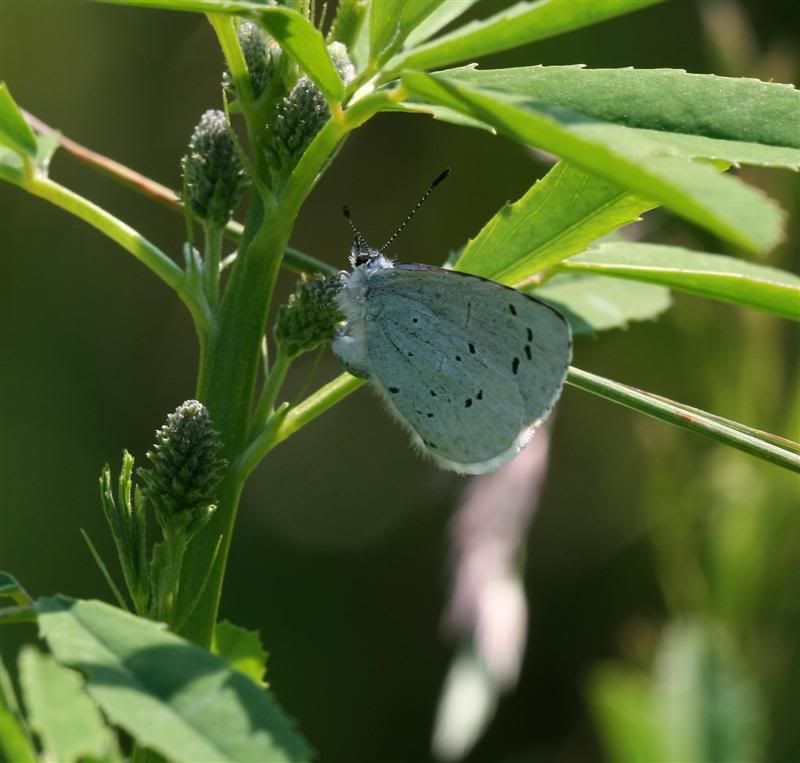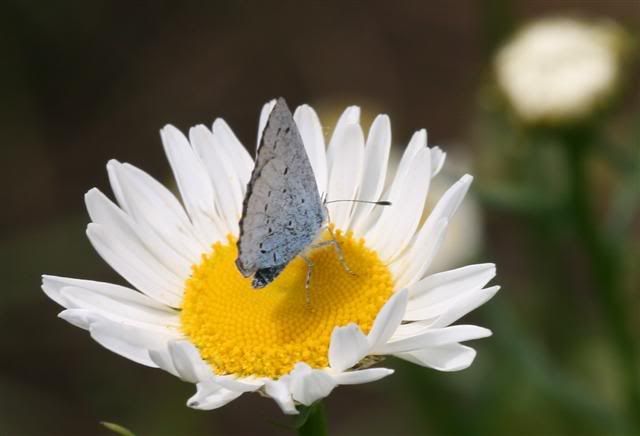hollyblues
-
thepostieles
- Posts: 127
- Joined: Fri May 02, 2008 8:40 pm
hollyblues
there seems to be alot of hollyblues about ive noticed, which is good news  keep forgetting though, do the larvae feed on holly in spring and ivy in autumn or vice versa?
keep forgetting though, do the larvae feed on holly in spring and ivy in autumn or vice versa?
- Pete Eeles
- Administrator & Stock Contributor

- Posts: 6869
- Joined: Tue Jan 17, 2006 6:10 pm
- Location: Thatcham, Berkshire
- Contact:
Re: hollyblues
From the species page: "Eggs laid in spring are typically laid on Holly, whereas the summer eggs are typically laid on Ivy". 
Cheers,
- Pete
Cheers,
- Pete
Life Cycles of British & Irish Butterflies: http://www.butterflylifecycles.com
British & Irish Butterflies Rarities: http://www.butterflyrarities.com
British & Irish Butterflies Rarities: http://www.butterflyrarities.com
- Rogerdodge
- Posts: 1182
- Joined: Tue Jan 31, 2006 6:06 pm
- Location: North Devon
Re: hollyblues
I have also noticed far more Holly Blues than I can remember before.
This following, what I recall as, a fairly poor 2nd brood last year.
Perhaps Jack is right, and they (2nd brood adults) "sense" a low population level, and put all energies into rapid procreation rather than whizzing about feeding, displaying, and generally enjoying themselves (unless procreation is enjoyable of course...)
Roger
This following, what I recall as, a fairly poor 2nd brood last year.
Perhaps Jack is right, and they (2nd brood adults) "sense" a low population level, and put all energies into rapid procreation rather than whizzing about feeding, displaying, and generally enjoying themselves (unless procreation is enjoyable of course...)
Roger
Cheers
Roger
Roger
- Dave McCormick
- Posts: 2388
- Joined: Fri Mar 16, 2007 8:46 pm
- Location: Co Down, Northern Ireland
- Contact:
Re: hollyblues
holly blues, yeah there is a lot where I live. Saw over 10+ on one holly bush the other day, mostly females and a few males. Some females were egg laying and males seemed good at defending the area from passing speckled wood/GV Whites.
There has not been a holly bush (with ivy nearby) that I have not seen a holly blue at where I live, and thats about 10 different locations in a 1 mile radius.
There has not been a holly bush (with ivy nearby) that I have not seen a holly blue at where I live, and thats about 10 different locations in a 1 mile radius.
Cheers all,
My Website: My new website: http://daveslepidoptera.com/ - Last Update: 11/10/2011
My Nature videos: http://www.youtube.com/user/DynamixWarePro
My Website: My new website: http://daveslepidoptera.com/ - Last Update: 11/10/2011
My Nature videos: http://www.youtube.com/user/DynamixWarePro
Re: hollyblues
I had a Holly Blue laying eggs on pyracantha. I have also seen them laying on Ceonothis in my garden during May/June.
Regards Lance
Re: hollyblues
I saw this individual in Broadcroft Quarry Portland last Sunday. There is no holly or ivy there, and she was laying om this unidentified plant.

Denise

Denise
- Neil Hulme
- Posts: 3599
- Joined: Fri Feb 08, 2008 8:27 pm
Re: hollyblues
Hi all,
I suspect that the undoubtedly high number of Holly Blues around this year, may reflect that the 'host-specific' parasitic ichneumon wasp Listrodomus nycthemerus had an even worse year (2007), due to the weather. In a similar fashion, the numbers of other species, which in some respect have an intimate (positive) association with other insects (e.g. 'downland Blues'), may be influenced by the weather-related fortunes of e.g. ants. This will of course be compounded by the more direct effects of temperature and rainfall.
Neil
I suspect that the undoubtedly high number of Holly Blues around this year, may reflect that the 'host-specific' parasitic ichneumon wasp Listrodomus nycthemerus had an even worse year (2007), due to the weather. In a similar fashion, the numbers of other species, which in some respect have an intimate (positive) association with other insects (e.g. 'downland Blues'), may be influenced by the weather-related fortunes of e.g. ants. This will of course be compounded by the more direct effects of temperature and rainfall.
Neil
Re: hollyblues
Yes - earlier this year in my local cemetery (where holly & ivy abundant) there were many 1st generation HB's - the best for some time. Have seen fewer 2nd generation so far (they started to emerge a couple of weeks ago) and certainly no peak, yet.
On another note - I have seen it said that they do not nectar - just pick-up moisture from leaves and honeydew. The other day I saw a couple nectaring (as it looked to me) on Russian Vine; any more ideas on do/don't nectar?
N
On another note - I have seen it said that they do not nectar - just pick-up moisture from leaves and honeydew. The other day I saw a couple nectaring (as it looked to me) on Russian Vine; any more ideas on do/don't nectar?
N
"Conservation starts in small places, close to home..."
-
thepostieles
- Posts: 127
- Joined: Fri May 02, 2008 8:40 pm
Re: hollyblues
i saw a hollyblue today nick,while on post, also a very fresh comma and ist small tort, yesterday 
Re: hollyblues
Hi Nick,NickB wrote:
On another note - I have seen it said that they do not nectar - just pick-up moisture from leaves and honeydew. The other day I saw a couple nectaring (as it looked to me) on Russian Vine; any more ideas on do/don't nectar?
N
I took this a few weeks ago. Looks like it's nectaring to me.

Holly Blues have always got their head stuck in bramble flowers around my way. Parhaps they like the smell
Cheers
Denise
Re: hollyblues
Thanks Denise
Maybe it is only the 2nd generation that DO nectar; thinking about it, not too many sources around for the 1st generation....
Must ask JackHarr - "he who knows all"!
N
(In fact the source of Info on nectaring was "Butterflies of Cambridgeshire" an excellent publication by the Cambs&Essex BC)
Maybe it is only the 2nd generation that DO nectar; thinking about it, not too many sources around for the 1st generation....
Must ask JackHarr - "he who knows all"!
N
(In fact the source of Info on nectaring was "Butterflies of Cambridgeshire" an excellent publication by the Cambs&Essex BC)
"Conservation starts in small places, close to home..."
Re: hollyblues
This one was nectaring off hemp agrimony last week. 
Re: hollyblues
The relationship between the Holly Blue and the ichneumon wasp Listrodomus nycthemerus is well documented and a natural cycle exists where each species ebbs and flows in population density according to that of the other.
When Holly Blue numbers reach a certain density the ichneumon wasp can really thrive, populations of this hymenopteran soar, until ultimately the Holly Blues numbers are adversely affected by a disproportionate number of these parasites. The result is a population crash which in turn impacts the nycthemerus numbers in subsequent years, resulting (it is considered) in the near (or actual) extinction of the parasite in certain areas. This then allows a natural boom in Holly Blue numbers as they are left to breed relatively free from this attractive little predator. Ultimately of course the Holly Blue numbers again reach a stage where nycthemerus can once again redistribute itself and begin to increase it's own population densities.
At some point during this cycle a point of relative harmony must be reached where both parasite and host coexist without the numbers of either one impacting the other adversely.
Holly Blue numbers have increased rapidly in recent years and one thing is fairly certain - nycthemerus will not be far behind....
The old "eggs laid in spring are on Holly, summer eggs are laid on Ivy" belief has been proven to be a little too much of a generalisation. While Holly Blues will use different larval food plants according to the generation to ensure that the young larvae have the tenderest flowers and developing seed so beneficial to their early development, Holly Blue will lay on a whole variety of food plants. Dog Wood is especially favoured by the spring brood, even it would seem in areas where there is plenty of Holly available.
Similarly a lone, large Holly will support a small colony all year round, with the summer brood larvae developing successfully on the young berries just as the spring brood larvae fed on the flowers and tiny developing fruits a few months earlier.
Felix.
When Holly Blue numbers reach a certain density the ichneumon wasp can really thrive, populations of this hymenopteran soar, until ultimately the Holly Blues numbers are adversely affected by a disproportionate number of these parasites. The result is a population crash which in turn impacts the nycthemerus numbers in subsequent years, resulting (it is considered) in the near (or actual) extinction of the parasite in certain areas. This then allows a natural boom in Holly Blue numbers as they are left to breed relatively free from this attractive little predator. Ultimately of course the Holly Blue numbers again reach a stage where nycthemerus can once again redistribute itself and begin to increase it's own population densities.
At some point during this cycle a point of relative harmony must be reached where both parasite and host coexist without the numbers of either one impacting the other adversely.
Holly Blue numbers have increased rapidly in recent years and one thing is fairly certain - nycthemerus will not be far behind....
The old "eggs laid in spring are on Holly, summer eggs are laid on Ivy" belief has been proven to be a little too much of a generalisation. While Holly Blues will use different larval food plants according to the generation to ensure that the young larvae have the tenderest flowers and developing seed so beneficial to their early development, Holly Blue will lay on a whole variety of food plants. Dog Wood is especially favoured by the spring brood, even it would seem in areas where there is plenty of Holly available.
Similarly a lone, large Holly will support a small colony all year round, with the summer brood larvae developing successfully on the young berries just as the spring brood larvae fed on the flowers and tiny developing fruits a few months earlier.
Felix.
- Tony Moore
- Posts: 810
- Joined: Tue Jul 01, 2008 6:37 pm
Re: hollyblues
Thanks, Felix, that has answered a question that I have long pondered. We have very healthy populations of both broods of HB close to where I live (Stafford). There is plenty of flowering Ivy, but no Holly at all in the immediate area. Stafford HBs are obviously totally hederaphagic (Oooh! Get him!  )
)
